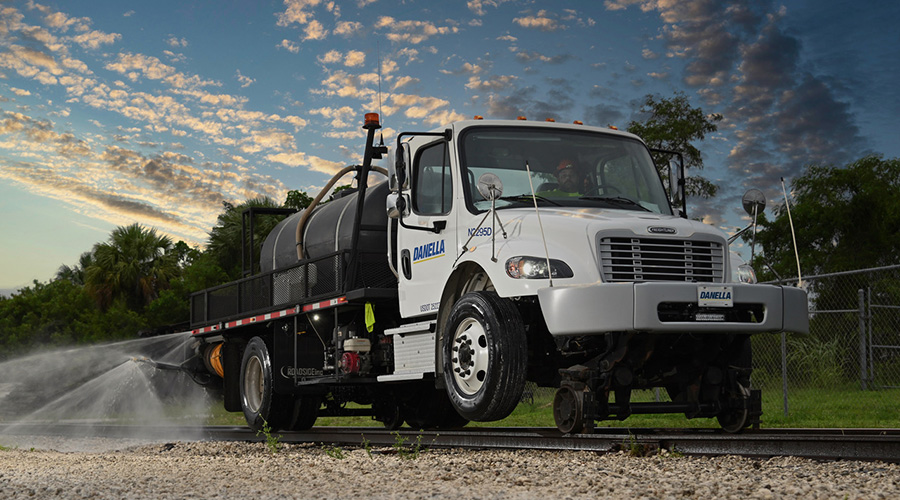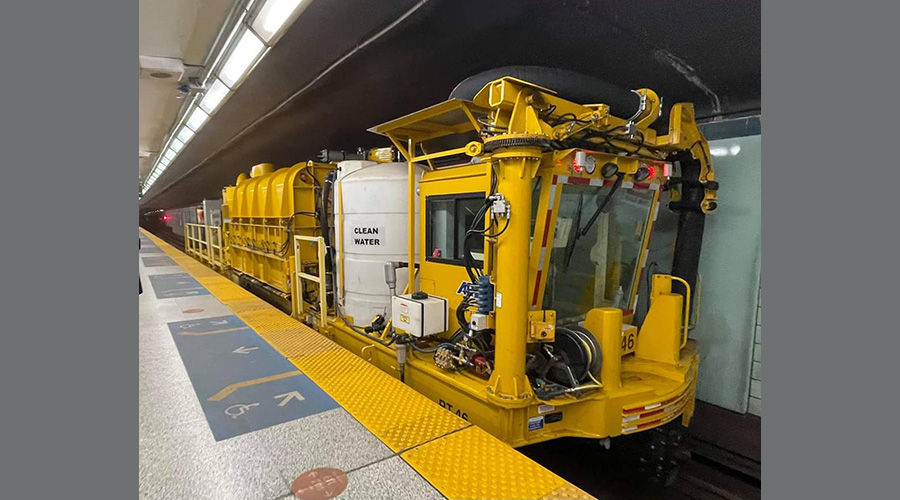Stay updated on news, articles and information for the rail industry
June 2015
Rail News: MOW
UW-Madison researchers hope frac-sand impact study will help railroads improve ballast maintenance
By Julie Sneider, Senior Associate Editor
University of Wisconsin-Madison researchers will spend the summer and fall studying the damage that frac sand can do to ballast after sand particles leak out of rail cars and onto railroad tracks.
Tuncer Edil, Jim Tinjum and Dante Fratta — professors at UW-Madison's College of Engineering — have spent years studying railway substructure stabilization and ballast fouling. More recently — as Wisconsin’s sand-mining industry has flourished in response to hydraulic fracturing — the trio has looked more closely at the impact frac sand has on ballast.
Wisconsin is the nation's leading producer of the fine silica sand, which is mixed with water and chemicals then blasted into the ground as part of the fracking process used in oil and gas drilling. Although hauling heavy carloads of frac sand from Wisconsin to shale fields in other states is good business for railroads, the impact of sand leaking from rail cars "is bad business for ballast," says Edil, emeritus professor of geological engineering.
Ballast deteriorates over time due to the weight of the trains and the vibration they cause when they rumble over the track. However, frac sand can hasten the deterioration when the sand particles fall into the void or spaces between the ballast rocks and accumulate in the ballast bed, Edil says. During a rainstorm, water adds to the mix to create a track-loosening muck. Over time, the cycle further deteriorates the ballast, which destabilizes the track. That causes railroads to lower their trains’ speed, and slower trains mean customers have to wait longer for their orders to be delivered.
"Some of the freight railroads have slowed down to 10 mph to go through a badly deformed segment of rail so the trains don’t derail," says Edil.
For railroads, replacing the ballast is a costly process, which includes lifting up the track, removing the rock and replacing it with new material.
"It's very expensive. It's also very expensive to have derailments," said Fratta — a professor of civil, environmental and geological engineering — in a prepared statement.
While the consequences of frac sand are a more recent development in ballast maintenance, the UW-Madison professors hope their research will lead to new ways of protecting and maintaining ballast against all kinds of stressors.
The scientists will soon begin monitoring ballast fouling problems and conditions along a segment of track in northern Illinois. Tinjum, a professor of geological engineering, will coordinate the academic and industry teams involved in the project, and Fratta will install fiber optic cable in the track to monitor temperature, deformation and vibration in the ballast, as well as deformation of the track.
For his part, Edil is working with the Texas-based soil stabilization and lifting company Uretek Holdings Inc. to develop a system that injects polyurethane into the voids of the ballast to keep out sand particles and other fouling materials. When injected, the polyurethane fills the voids between the rocks and hardens in about 15 minutes — an advantage over cement, which would take days or longer to set, Edil says.
"We did a lab study to inject polyurethane into clean ballast, and got very good results," he adds. "The levels of deformation were essentially eliminated."
Another potential time saver: the polyurethane injections could be made through small pipes into the existing ballast without having to lift the track, which allows the process to be completed with little or no interruption to rail traffic.
So now the experiment must move out of the lab in Madison and onto the track in northern Illinois. The injections will be made and monitored in controlled sections to analyze effectiveness, Edil says.
The researchers want to make sure that the polyurethane injection method works to stabilize the ballast at a lower cost than the railroad industry’s traditional methods — and leaves a smaller carbon footprint in the process.
Producing replacement ballast requires energy resources, but so does making polyurethane. Edil and Uretek have conducted a life-cycle analysis to determine whether the new method would reduce greenhouse gas emissions and use less energy, according to a UW-Madison press release.
Adds Edil: "My main push is to try to solve the rail industry's basic problem of deteriorating ballast: How can you fix it, how can you maintain it, and how can you use methods that are environmentally friendly?"


 LRW Honors Amtrak’s Acheson As Railway Woman Of The Year
LRW Honors Amtrak’s Acheson As Railway Woman Of The Year
 From Editor-In-Chief Foran: Of Gender Equity And Inclusion
From Editor-In-Chief Foran: Of Gender Equity And Inclusion
 Spotlight On Some Of Today’s Rail Safety Products
Spotlight On Some Of Today’s Rail Safety Products
 Women of Influence in Rail eBook
Women of Influence in Rail eBook
 railPrime
railPrime







